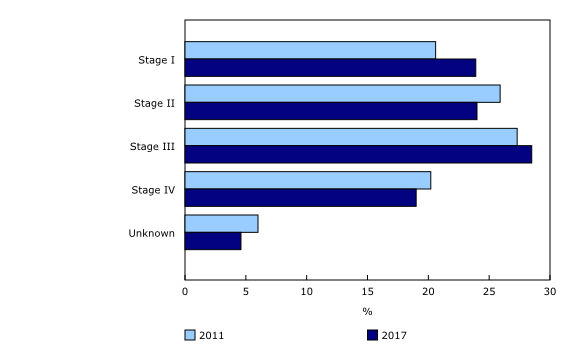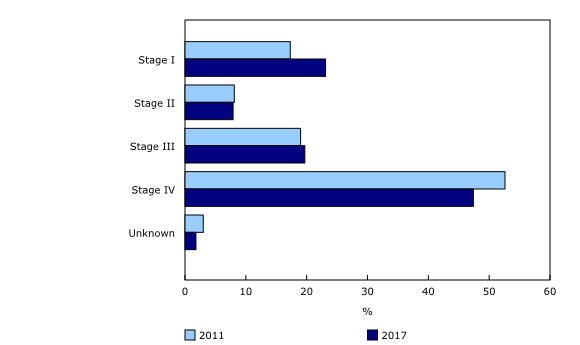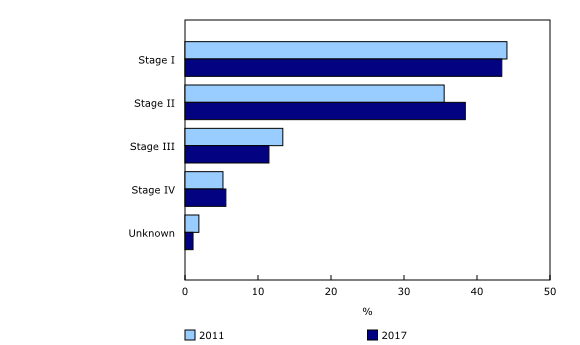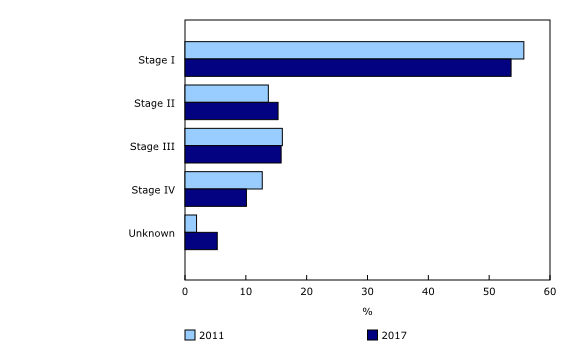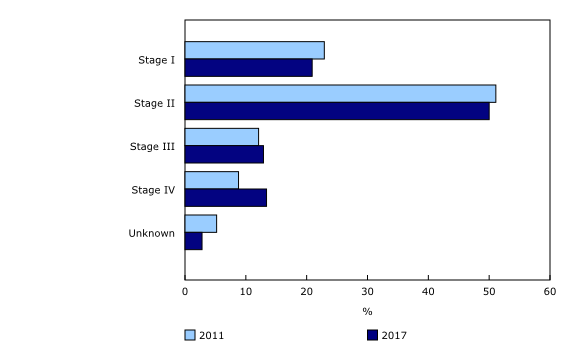Cancer incidence by stage in Canada, 2017
Archived Content
Information identified as archived is provided for reference, research or recordkeeping purposes. It is not subject to the Government of Canada Web Standards and has not been altered or updated since it was archived. Please "contact us" to request a format other than those available.
Released: 2020-03-09
Thousands of Canadians receive a cancer diagnosis every year in Canada. Cancer staging, the extent of the disease in the body, is a recognized way of describing and classifying a cancer based on its progression. In 2017, some cancers such as cervical, breast and prostate cancer tended to be diagnosed at an early stage, whereas others such as lung and bronchus cancer were more likely to be diagnosed at a later stage. Generally, a cancer that is diagnosed at an earlier stage is easier to treat, and patients have a higher chance of survival than those diagnosed when a cancer has progressed further.
Today, data tables for cancer incidence by stage at diagnosis in Canada are being released for the first time. The Canadian Cancer Registry, a population-based registry that includes data collected and reported to Statistics Canada by the provincial/territorial cancer registries, contains cancer stage data, from all provinces and territories except Quebec (see note to readers) for the four most commonly diagnosed cancers: breast, lung and bronchus, prostate, and colorectal. Stage data for cervical cancer are also available for all provinces excluding Quebec and New Brunswick.
Trends in the stage of cancer at diagnosis vary according to cancer type
In 2017, over half of all cases of cervical cancer (53.6%) were diagnosed at stage I, and more than 8 in 10 breast cancer cases (81.8%) were diagnosed at either stage I or II. Similar trends were observed for prostate cancer, where slightly more than 2 in 10 prostate cancer cases (20.9%) were diagnosed at stage I, and exactly half (50.0%) were diagnosed at stage II.
Colorectal cancer diagnoses were more evenly distributed across stages, with close to half of the cases (47.9%) diagnosed at stage I or II, just over one-quarter (28.5%) diagnosed at stage III and close to 2 in 10 diagnosed at stage IV (19.0%).
Lung and bronchus cancer was more likely to be diagnosed at a later stage, with over two-thirds of cases (67.2%) diagnosed at either stage III or IV. This cancer is the leading cause of cancer deaths in Canada, taking the lives of approximately 20,000 people every year.
Younger patients more likely to be diagnosed at an earlier stage for both cervical and prostate cancer
Age and stage at diagnosis can be related for certain cancers. Younger patients were more often diagnosed at earlier stages for both cervical and prostate cancer. For instance, the average age at diagnosis for stage I cervical cancer (45.0 years of age) was much younger than for stage IV cervical cancer (57.2), and a similar trend exists for prostate cancer, with the average age at diagnosis for stage I (65.6) being younger than for stage IV (72.6).
Most cancer types continue to be diagnosed at the same stage
Most cancers were diagnosed at the same stage in 2017 as they were in 2011. Both cervical and breast cancers continued to be most often diagnosed early, at stage I, potentially linked to successful screening programs in place for these cancer types. Prostate cancer continued to be most often diagnosed at stage II (50.0%), colorectal cancer at stage III (28.5%), and lung and bronchus cancer at stage IV (47.4%).
Notably, lung and bronchus cancer diagnoses improved slightly in 2017. While this cancer was still typically diagnosed at a later stage than other cancers, in 2017, a larger proportion of cases were diagnosed at stage I (23.1%) than in 2011 (17.3%), and a smaller proportion of cases were diagnosed at stage IV (47.4%) than in 2011 (52.6%).
Note to readers
The Canadian Cancer Registry (CCR) is a population-based registry that includes data collected and reported to Statistics Canada by each provincial/territorial cancer registry. The goal of the person-based CCR is to collect information about each new primary cancer diagnosed among Canadian residents since 1992.
Cancer incidence refers to the number of new cases of cancer in a population over a given period, usually one year. Cancer incidence rates are typically expressed as the number of new cancer cases per 100,000 people.
Cancer staging assigns the diagnosed cancer a stage (typically 0 to IV) that summarizes the state of the cancer at the time of diagnosis. In Canada, cancer is most often staged using a range that can be described as follows:
- 0: non-invasive cancer; only abnormal cells that may develop into a cancerous tumour
- I: tumour is small and contained within the organ in which it started
- II: tumour has grown and may have begun to spread
- III: tumour is large and has spread into nearby tissues and lymph nodes
- IV: cancer has spread through the blood or the lymphatic system to distant sites in the body
Cancer staging data for Quebec are not available for diagnosis years 2011 and onward. For tables 13-10-0761-01 and 13-10-0762-01, cancer incidence estimates by cancer stage for Canada, excluding Quebec, were produced for all diagnosis years. Also, staging data are not available from New Brunswick for cervical cancer for the 2011-2017 reference period.
As the CCR is updated annually with new records and changes to previous records, the incidence for any given diagnosis year may change from one release to the next. In particular, delays in the reporting of new cases to Statistics Canada typically result in undercounts of cases, which are more pronounced in the most recently reported diagnosis year. Generally, the reporting delay ranges between 2% and 3% nationally. In addition, cancer cases identified from the death certificate only were not reported by Ontario in 2017 and for Manitoba since 2013. This would amount to approximately an additional 1,000 cases for 2017 that are not reflected herein, but that will eventually be reported to the CCR.
For the 2011-2017 diagnosis years, the staging of the cases was done using the Collaborative Stage framework as described in the seventh edition of the American Joint Committee on Cancer (AJCC) Cancer Staging Manual, Springer, 2010.
The proportions presented in this document are based on cancer cases that have been validly staged and have been assigned one of the following values: I, II, III, IV or unknown. Non-invasive tumours (stage 0), as well as tumours that were not staged, were excluded from the analysis.
Contact information
For more information, or to enquire about the concepts, methods or data quality of this release, contact us (toll-free 1-800-263-1136; 514-283-8300; STATCAN.infostats-infostats.STATCAN@canada.ca) or Media Relations (613-951-4636; STATCAN.mediahotline-ligneinfomedias.STATCAN@canada.ca).
- Date modified:


